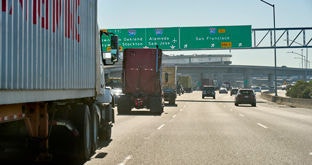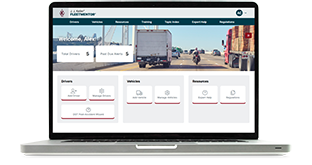Transport Safety Editor — J. J. Keller & Associates, Inc.
Track Your Fleet for California Compliance
The California Air Resources Board (CARB) has several long-standing programs in place, and three new programs rolling out in 2024. Do you know which ones apply to your operations?
Published On: 08/07/2024


Written by:
Corrina Peterson
There is a lot to keep track of when it comes to emissions regulations, especially if your trucks operate into California – and regardless of where they are registered. While some programs apply to vehicle manufacturers, others create obligations for vehicle owners and operators.
The California Air Resources Board (CARB) regulates air emissions in California. It has several long-standing programs in place and three new programs rolling out this year (2024). Do you know which ones apply to your operations?
Fleets: Clean Truck Check (also known as the HD I/M regulations)
This program requires all non-gasoline powered vehicles that operate in California with a GVWR of 14,001 pounds or more to be registered in CARB’s CTC-VIS database. Part of registering includes paying a $30 per vehicle annual compliance fee.
This program also requires vehicle owners or operators to upload onboard diagnostic (OBD) data to CARB proving that the vehicle is operating within its designed emissions parameters starting in January of 2025. The submission due dates are based on:
- The vehicle's plate expiration date if registered/plated in California, or
- The last digit of the VIN if registered/plated in another state.
Fleets: Advanced Clean Fleet
Under the Advanced Clean Fleet (ACF) regulation, drayage trucks and high priority fleets will have to register their California fleet (vehicles used in California) in CARB’s TRUCRS system. This is currently voluntary for high priority fleets but may become mandatory soon.
High priority fleets under the ACF program are fleets that operate vehicles with a GVWR of 8,501 pounds or more in California and have 50 or more vehicles or an annual revenue of $50 million or more.
This program requires covered fleets to begin replacing the internal combustion engine (ICE) units used in their California fleet with zero emissions vehicles (ZEVs) beginning next year. When registering in TRUCRS, companies must declare which option they will use:
- Model year: Under this option, whenever a vehicle is purchased for the California fleet, it must be a ZEV, unless an exemption applies.
- Planned phase-in: This option allows a company to phase in ZEVs over a 12-year span.
Fleets: Truck and Bus, GHG, Drayage, and PSIP are still in place
Several other important CARB emissions programs remain active:
- The Truck and Bus program requires all vehicles with a GVWR of 14,001 pounds to have a model year (MY) 2010 or newer engine.
- The Greenhouse Gas Reduction (GHG) program requires van-type trailers that are over 50 feet in length (and the tractors pulling them) to have full aerodynamics and low rolling resistance tires.
- The Drayage Truck program requires all trucks that operate into, out of, and inside of rail ramps and ports (called drayage trucks) to be registered in the CARB Drayage Truck database and equipped with a 2010 or newer engine.
- The Periodic Smoke Inspection Program (PSIP) remains active until the CTC program is fully implemented in 2025. This regulation requires fleet owners/operators to have their California-based diesel-powered vehicles with a GVWR of 6,001 pounds or more undergo an annual smoke opacity test once the vehicle reaches four years old (based on model year).
Manufacturers: Advanced Clean Truck
Under CARB’s Advanced Clean Truck (ACT) rule, manufacturers must sell a specific percentage of ZEVs to be able to sell vehicles in California.
Manufacturers: EPA vehicle standards
The Environmental Protection Agency (EPA) Control of Air Pollution from New Motor Vehicles: Heavy-Duty Engine and Vehicle Standards rule was finalized in 2022. This rule applies to the manufacturers of on-highway heavy-duty trucks and engines. It begins implementation with MY 2027.
Recent EPA Greenhouse Gas Emissions Phase 3 final rules apply to the manufacturers of on-highway heavy-duty trucks. As of MY 2028, manufacturers must reduce greenhouse gas emissions across their day cab offerings by 8% annually until 2032.
Plan for compliance
There are several different emissions programs to comply with if you operate into California. The key is knowing which ones apply to your operations.
Use the Vehicles & Equipment tool in FleetMentor to manage your inventory of vehicles and equipment. Stay on top of annual inspections, plate renewals, service status, and lease dates using the alert functionality and reporting.
Not a FleetMentor user? Start your 30-Day Free Trial today!

J. J. Keller® FleetMentor® Service
The J. J. Keller® FleetMentor® System serves and supports thousands of transportation professionals every day with problem-solving tools and guidance. Whether you have one truck or a thousand, a fleet of commercial motor vehicles or F-150s, or haul goods or provide services — FleetMentor has you covered.
You may also enjoy the following articles:
Sign up for our newsletter!
We'll help you stay on top of regulations, best practices, and fleet industry news. Sign up to receive a monthly email notification with links to our most recent blog articles, free resources, and event invites.